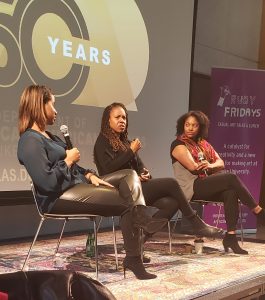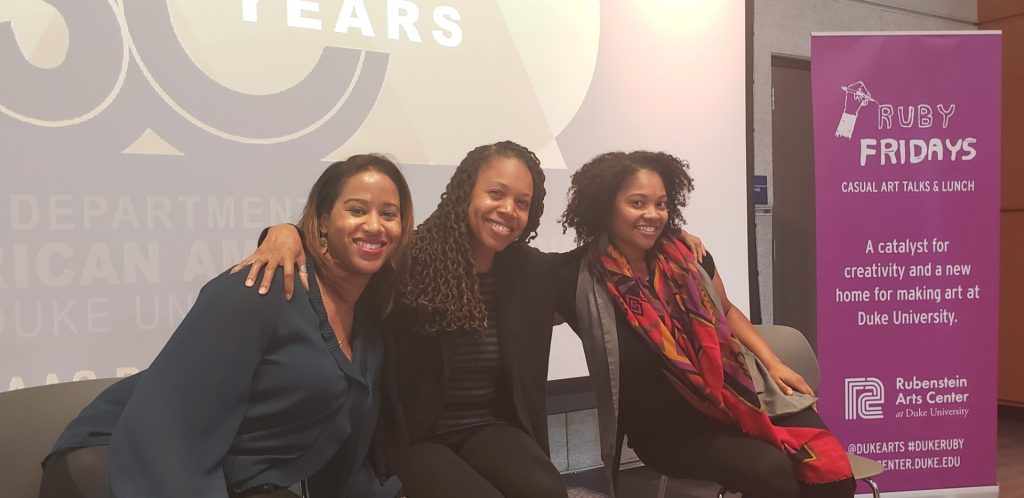Home » Posts tagged 'Durham'
Tag Archives: Durham
Local Black Women Artists join Professor Neal for Ruby Fridays
 Three black women artists, members of the vibrant and supportive Durham arts community, shared details of their creative practices, and the challenges and joys of being working artists at a Nov. 15 “Ruby Fridays” event.
Three black women artists, members of the vibrant and supportive Durham arts community, shared details of their creative practices, and the challenges and joys of being working artists at a Nov. 15 “Ruby Fridays” event.
Durham-based visual artists Candy Carver and Natasha Powell Walker, and independent filmmaker Natalie Bullock Brown joined Mark Anthony Neal, the James B. Duke Professor of African & African American Studies, for a lunchtime public conversation in the Ruby Lounge at the Rubenstein Arts Center.
The event was held in conjunction with the 50th anniversary of the Department of African & African American Studies.
On being a working artist and having “day jobs”:
WALKER: I just got comfortable telling people at my nonprofit “day job” that I’m an artist. It’s easier at a nonprofit where people have lives. It’s been interesting to see how much they intersect, my “day job” and my art.
BROWN: My parents were supportive. They said make sure you get an advanced degree. I had worked on the Ken Burns Jazz series. I was really worried at age 27 that if I didn’t get married soon, I would not have kids. I left New York and moved here. I now have 2 children and I am married. I just got back to filmmaking about 6 years ago. I started teaching, mostly because I had flexibility with my schedule.
Every waking moment is teaching, filmmaking, kids. It’s challenging.
The funding part, in N.C., I have not figured that out yet. I’m 6 years into a project that I could have done in 3 years in New York.
CARVER: I don’t have a 9-to-5 but I work all the time. It’s fun.
I actually work more than 9-to-5. It’s more than a full-time job, if we’re talking about 40 hours a week. My job can travel with me. I have a lot more flexibility than a 9-to-5. I’m currently figuring out balance, and opportunities that won’t cost me time. I need to be happy to make good work, unlike Mary J. Blige.
 On the challenges of being an artist in the Triangle area:
On the challenges of being an artist in the Triangle area:
CARVER: There’s a challenge that many of the art galleries are run by white women and that’s a particular perspective that they are choosing art from.
As our area becomes more diverse they will have to seek from a more diverse spectrum of creativity. Black life is way more interesting than shackles, chains and lunch counters. It’s more interesting and it’s broader.
On being taken seriously as women:
WALKER: I’ve experienced harassment. I’ve had both male and female mentors tell me to use it to my advantage, or that’s just the way it is.
CARVER: The majority of my clients are men. Why? I would have thought it would be more women. I’m not sure why. But I’m comfortable with guys. Always have been.
BROWN: Women don’t get as much funding as men. You might have to work on projects where you’re token, or the topic is black and you’re being used for your blackness.
It doesn’t matter if you went to film school. What matters is experience. I want the chance to do artwork that will help me to grow.
On where they create:
WALKER: I like creating at home. I don’t like people walking up to me while I’m creating. I had a studio space in Richmond that I shared.
CARVER: The whole downstairs of my house is an art studio. My dining room and living room are full of art supplies. I’m social, dialoguing doesn’t disrupt me too much. I actually enjoy it. I paint on the floor. It feels nice. I’ve painted on the walls. My mother learned pretty early that I was a different kind of kid.
What will you be doing 5 years from now?
CARVER: That’s so limiting. If I had done what I thought 5 years ago I would have missed out on so much.
I’m working on figuring out ways to make more money and work less.
On “black girl magic”:
CARVER: It’s the ability to pivot, to constantly and successfully adjust.
BROWN: It agree that it is being able to react in the moment to what is needed. It’s being able to have joy in the midst of all of the challenges. Also, it has begun to encapsulate this idea of being a superwoman, which is not real, not healthy, not sustainable.
Magic has be paid, funded, supported or it will fizzle.

To Go Down Dilapidated: A Case For Removing Confederate Monuments
 By Mark Anthony Neal
By Mark Anthony Neal
As protests go, the pulling down of Confederate monuments is low-hanging fruit. They are largely symbolic acts directed at symbols that, by and large, have long been relegated to unread history books and museums. But low-hanging fruit can also be poisonous.
State laws passed to protect these monuments—to weaponize them—are now being used to undermine the work of social justice activists and quell resistance. The “Historic Artifact Management and Patriotism Act,” was passed by the North Carolina state legislature in July 2015, roughly a month after activist Bree Newsome brought down the Confederate flag at the State Capitol in South Carolina in response to the shooting deaths of nine Black parishioners in Charleston, S.C. by Dylann Roof.
Newsome’s act became a social media moment that inspired many other acts of resistance— including Colin Kaepernick’s kneeling protest.
The 2015 law is also the subtext of the recent arrest of Takiyah Thompson, a 22-year-old North Carolina Central University (NCCU) student, who was among a group of activists and protesters who helped bring down a Confederate monument in the city of Durham earlier this week. Additional protesters have subsequently turned themselves into authorities.
A day after footage of Thompson scaling the structure to place the rope that was used to pull it to the ground went viral, she was arrested by Durham County sheriff’s deputies. Thompson was charged with four counts, including two felony charges for participation in a riot with property damage in excess of $1,500 and inciting others to riot where there is property damage in excess of $1,500. That the sheriff’s deputies patiently waited for Thompson to finish speaking at a press conference arranged on NCCU’s campus, speaks less to their recognition of her first amendment rights as it was public show of the sanctity of state laws.
Yet what these Durham activists understand is the fact not all laws are just. Indeed, the very states that have enacted laws to protect Confederate totems from removal by local municipalities and individuals, also understand that not all laws are just.
Durham’s Black city manager dubbed the protest “unlawful and inappropriate” and there were many, who, while affirming the goals of the takedown, were less supportive and even critical of the means in which the monument was taken down. Yet, if the Civil Rights era activists would have been able to use Twitter or Instagram 60 years ago, they likely would have used hashtags like #unlawful and #inappropriate, which would have been entirely appropriate in the context of struggles against laws that were unjust and absurd.
Rosa Parks broke an unjust law to challenge the treatment of Black people on public transportation in the South. When four students from North Carolina A&T sat at a “Whites only” lunch counter in Greensboro, they were pushing back against an unjust law—also a reminder of the role that HBCUs play in cultivating political consciousness among young Black people. Every enslaved African that chose to leave a plantation, under the cover of the night and live their lives as fugitives, knowingly broke, what they correctly deemed unjust laws. Indeed, there have been few examples of successful social justice movements that did not include the breaking of unjust laws, from the challenging of unlawful assemblies to illegal work stoppages. Generations ago, we quaintly named such activities as “Civil Disobedience” and can be traced to the writings of Henry David Thoreau in the 1840s.
The tearing down of the symbols and trinkets of the confederacy might seem like low-hanging fruit, but when we are more concerned as a society about the treatment of formed pewter than about the treatment of people forced to live under the policies and tactics shaped by those symbols, then it is indeed time to take a stand. After a successful fundraising campaign Thompson was freed on bail hours after her arrest. It was a reminder there are some willing to stand on the side of justice.
Mark Anthony Neal is chair of the Department of African and African American Studies at Duke University. Follow him on Twitter at @NewBlackMan.
Originally published in Cassius Life, Aug. 17, 2017.




